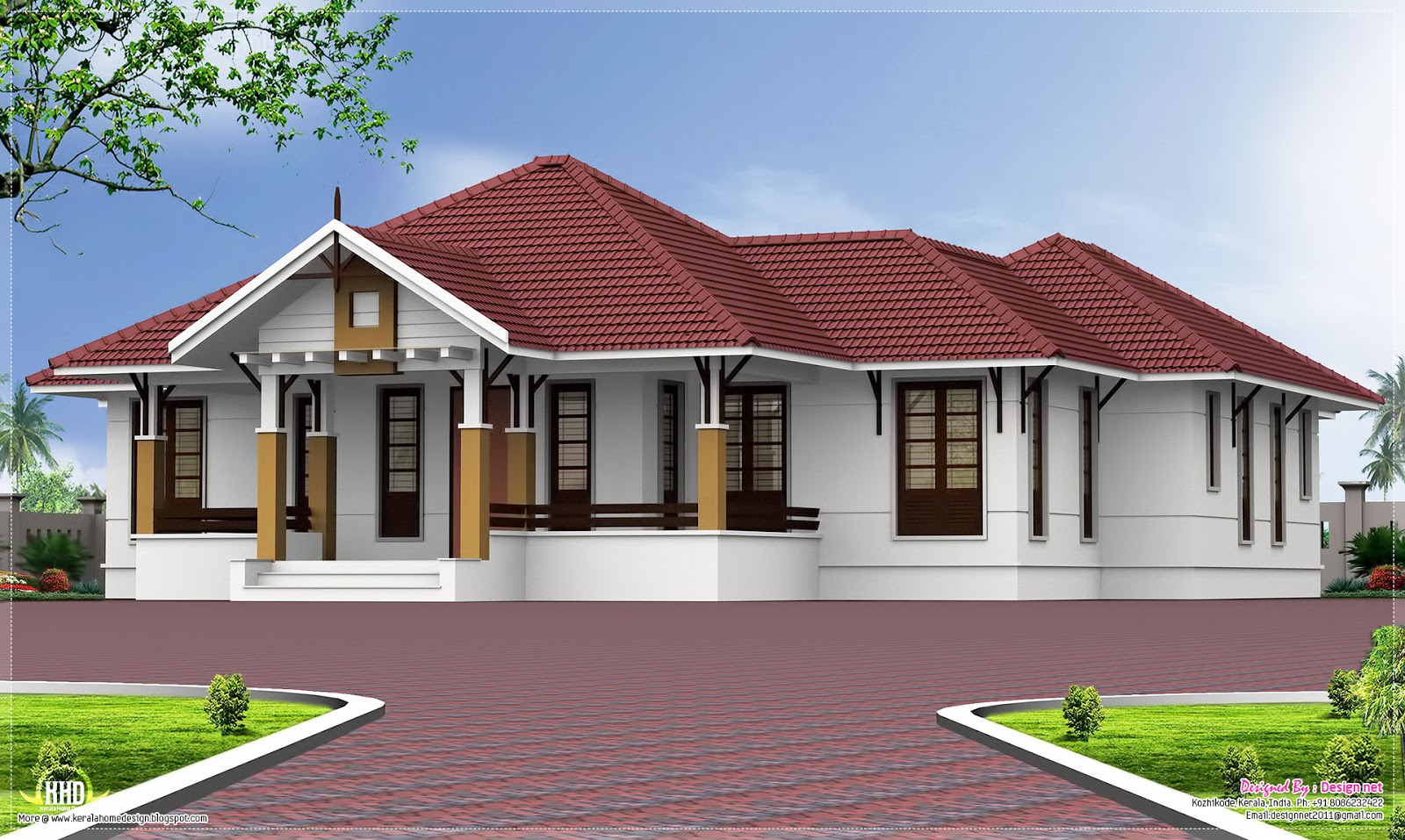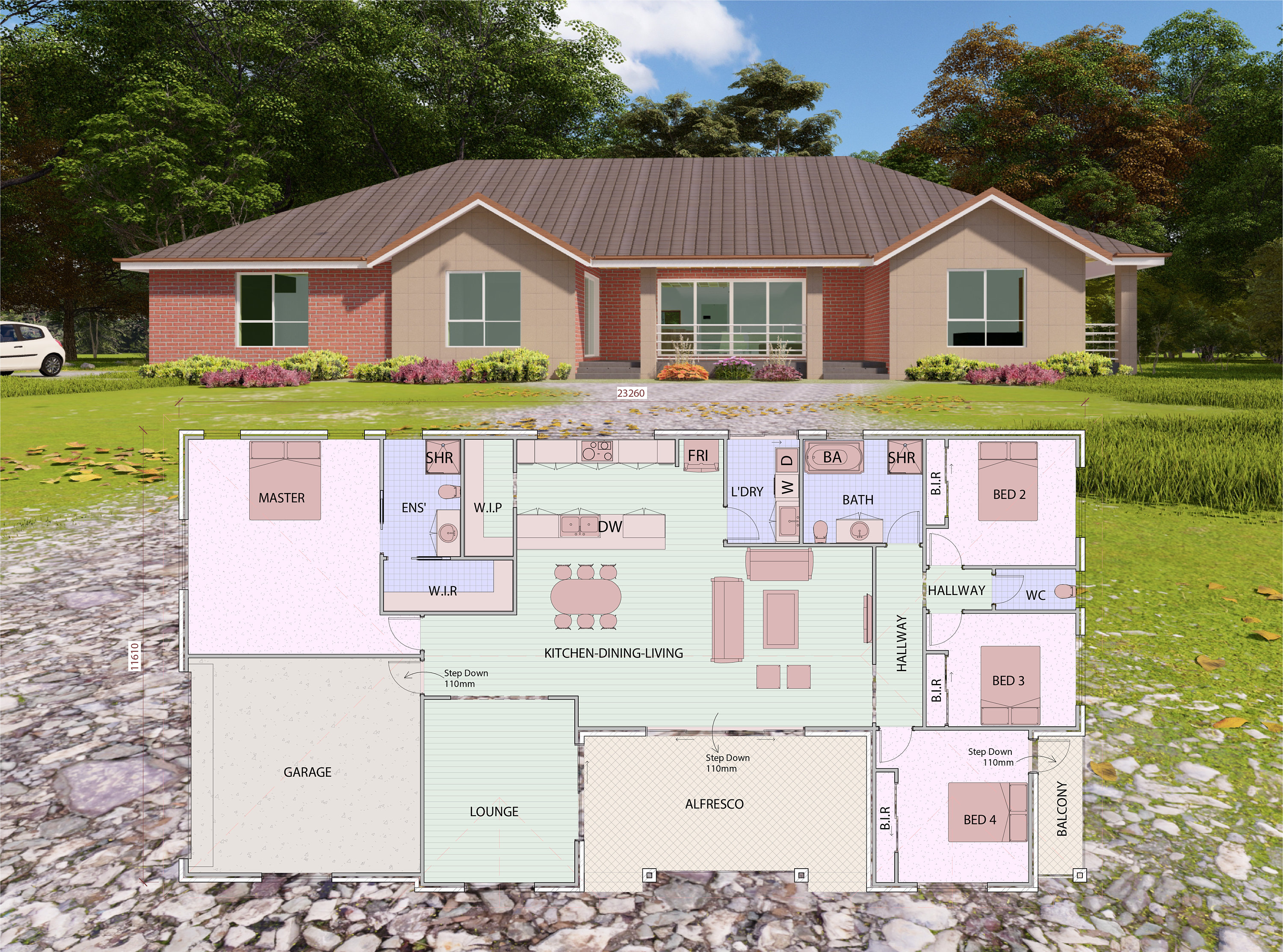Understanding the Bungalow Design Concept

The bungalow, a beloved architectural style, is known for its charming simplicity and practicality. It’s a single-story dwelling, often featuring a low-pitched roof, and a focus on creating an open and inviting living space.
Origins and Evolution of the Bungalow Style, Architectural design for 4 bedroom bungalow
The bungalow style originated in India during the British Raj, where it was initially designed as a modest, single-story dwelling for British officials. The concept of a simple, functional home with a focus on outdoor living quickly caught on, and the bungalow style spread to other parts of the world.
The bungalow’s popularity soared in the early 20th century, particularly in the United States and Canada. It became synonymous with the Arts and Crafts movement, which emphasized simplicity, craftsmanship, and a connection to nature. During this period, bungalow designs evolved to incorporate local building materials and architectural influences.
Iconic Bungalow Designs
The bungalow style has inspired numerous iconic designs, each showcasing unique features and variations. Here are some notable examples:
- The Craftsman Bungalow: This style, popular in the early 20th century, features a low-pitched roof, exposed beams, and a focus on natural materials such as wood and stone. It often includes a front porch and a large fireplace, creating a cozy and inviting atmosphere. The Greene and Greene brothers, renowned architects, are credited with popularizing the Craftsman bungalow style.
- The Prairie Bungalow: Inspired by the flat landscapes of the American Midwest, the Prairie bungalow features horizontal lines, low-pitched roofs, and large windows to connect the interior with the outdoors. Frank Lloyd Wright, a prominent architect, is known for his iconic Prairie bungalow designs, such as the Robie House in Chicago.
- The California Bungalow: This style, popular in California during the early 20th century, combines elements of the Craftsman and Prairie styles with Spanish and Mediterranean influences. It often features stucco walls, red tile roofs, and a focus on creating a relaxed and casual living space. The California bungalow is known for its open floor plan, large windows, and outdoor living areas.
Designing a 4-Bedroom Bungalow: Architectural Design For 4 Bedroom Bungalow

A 4-bedroom bungalow provides ample space for a growing family, offering flexibility in layout and functionality. The design process involves optimizing space utilization, maximizing natural light, and ensuring smooth flow throughout the home. This section delves into the crucial aspects of designing a functional and comfortable 4-bedroom bungalow.
Floor Plan Considerations
A well-designed floor plan is the foundation of a functional bungalow. The layout should prioritize space efficiency, flow, and natural light. The primary goal is to create a comfortable and inviting living environment that caters to the specific needs of the family. A thoughtfully planned floor plan ensures a harmonious blend of functionality and aesthetics.
“A good floor plan is like a good story – it has a beginning, a middle, and an end, with each element flowing seamlessly into the next.”
Here are some essential elements to consider when designing a floor plan for a 4-bedroom bungalow:
- Entryway: A welcoming entryway sets the tone for the entire home. It should be spacious enough to accommodate guests and provide storage for coats, shoes, and other essentials. Consider adding a mudroom or a dedicated space for storing outdoor gear.
- Living Area: The living area is the heart of the home. It should be large enough to accommodate comfortable seating, a TV, and any other desired furniture. Natural light is crucial, so ensure large windows or skylights. Consider an open floor plan that connects the living area to the dining room and kitchen, creating a spacious and inviting atmosphere.
- Dining Area: The dining area should be conveniently located near the kitchen and living area, allowing for easy flow during meals and entertaining. A well-lit dining space with ample seating is essential for family gatherings.
- Kitchen: The kitchen is the central hub of the home. It should be designed for functionality and efficiency. Consider a layout that optimizes workflow and provides ample counter space, storage, and appliances. A well-designed kitchen makes cooking and entertaining a joy.
- Bedrooms: The four bedrooms should be thoughtfully positioned for privacy and comfort. Consider a master bedroom with an en-suite bathroom and walk-in closet for added luxury. The remaining bedrooms can be designed for children, guests, or home office use.
- Bathrooms: The number and placement of bathrooms depend on the family’s needs. A master bathroom with an en-suite shower and bathtub provides privacy and convenience. Additional bathrooms can be shared between the other bedrooms or located near the living areas for guests.
- Additional Rooms: Consider including additional rooms like a home office, a playroom, or a guest room. These spaces provide flexibility and cater to the family’s diverse needs.
Exterior Design and Aesthetics
The exterior of your bungalow is the first impression it makes, and it’s important to choose a style that reflects your personal taste and complements the surrounding environment. This section explores different exterior styles, material choices, and landscaping ideas that can help you create a beautiful and functional bungalow.
Exterior Styles
The exterior style of your bungalow can be influenced by various architectural trends. Here are some popular options:
- Traditional Bungalow: Characterized by low-pitched roofs, wide eaves, and a cozy, welcoming feel. Common features include front porches, dormer windows, and stone or brick accents.
- Modern Bungalow: Embraces clean lines, geometric shapes, and a minimalist aesthetic. Features may include flat roofs, large windows, and a focus on natural materials like wood and concrete.
- Contemporary Bungalow: Blends modern elements with traditional bungalow features. This style often incorporates sustainable materials, innovative design features, and a focus on indoor-outdoor living.
Material Choices
The materials you choose for your bungalow’s exterior will significantly impact its overall look and feel. Here are some popular options:
- Brick: Durable, low-maintenance, and offers a classic, timeless aesthetic. Brick can be used for walls, chimneys, and accents.
- Stone: Adds a rustic, natural charm and can be used for walls, foundations, and decorative elements. Natural stone comes in various colors and textures, allowing for unique design possibilities.
- Wood: Warm, inviting, and offers a range of finishes. Wood can be used for siding, trim, and architectural details.
- Stucco: Smooth, textured, and versatile. Stucco can be used for walls, accents, and decorative elements. It’s available in a wide range of colors and finishes.
Landscaping Design
Landscaping plays a crucial role in enhancing the beauty and functionality of your bungalow. A well-designed landscape can complement the architecture, provide privacy, and create inviting outdoor spaces. Here are some key considerations:
- Gardens: Incorporate flower beds, vegetable gardens, or herb gardens to add color, fragrance, and a sense of tranquility.
- Patios: Create a dedicated outdoor living space for entertaining, dining, or simply relaxing. Consider using materials like stone, brick, or wood for the patio surface.
- Walkways: Design walkways that connect different areas of your property, providing easy access and enhancing the overall flow.
- Lighting: Install outdoor lighting to illuminate walkways, enhance safety, and create a warm ambiance in the evening.
